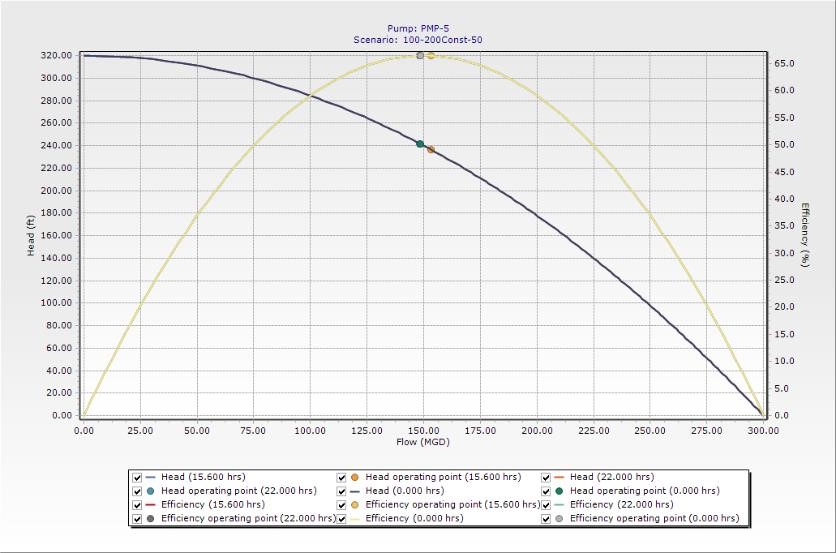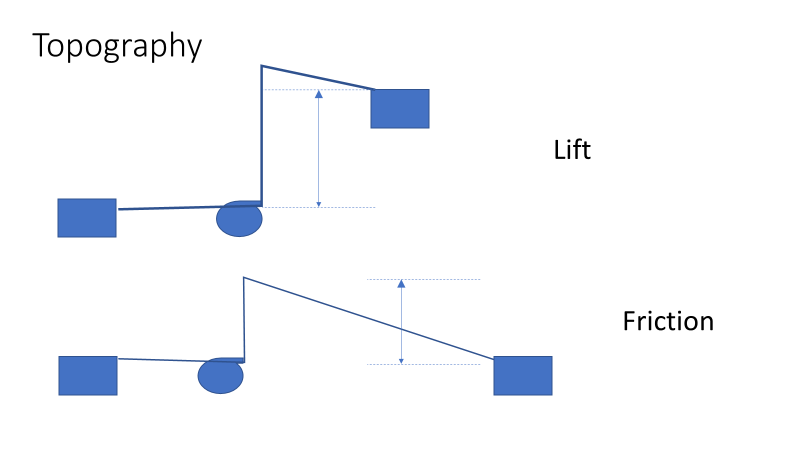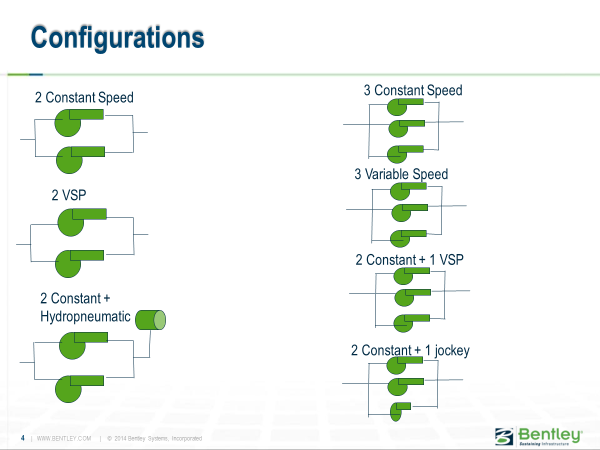Virtuosity Blog
Variable Speed Pumps vs. Constant Speed Pumps
The most common question in pump selection these days is whether to use variable or constant-speed pumps.
There are some applications where a pump must discharge into a closed system to meet continuously varying demands where a variable speed pump could pay for itself in a short time. But what about water and wastewater systems?
(First, a digression. There is no such thing as a variable speed pump. A pump is a pump. What constitutes variable-speed pumping is a variable-speed motor attached to a pump. A variable frequency drive (VFD) is the best technology these days to produce variable speed. So, I’ll call the pump, VFD and motor together as a variable speed pump.)
The selection of the pumping technology should be based on life cycle costs (plus some other considerations) and depends heavily on the nature of the pumped system. There are essentially two types of systems – those that have floating storage and those that don’t. This makes a big difference in the type of analysis required.
Systems with Storage
Systems with storage have a significant advantage in pumping in that it is possible to turn the pumps(s) OFF. This storage can refer to an elevated water storage tank or a sewage wet well. If you correctly select the right constant speed pump, you can run it at an efficient operating point to fill the storage tank or drain the wet well and turn it off. I’ve done a lot of calculations along these lines, and constant speed pumping almost always wins.
If you have a constant speed pump, you can consistently run it at an efficient point as shown below.

This leads to what I’ll call Walski’s law for variable speed pumping, “The most efficient speed to run a variable speed pump is OFF.”
But as with everything else in life, there are exceptions to the rules. The first exception depends on the shape of the system head curve. Most water, and to a lesser extent, sewage pumping involves a fairly flat system head curve. Water is lifted from one pressure zone to the next higher one or lifted over a drainage divide. It is very difficult to turn down the speed without seriously hurting the efficiency. However, if you are pumping across flat ground, most of the energy is used to overcome friction, and the flow can be adjusted without having as much detrimental effect on efficiency. The friction-dominated case may favor a variable speed pump.
 One situation where variable speed pumping may be better is the case of a manifold force main in flat terrain, where multiple pump stations discharge into a common force main, and the flows vary widely. During dry weather, only one or two pumps may be running, and the pressure in the force main may be low. However, in wet weather, most of the stations may be running simultaneously, and the pressure may be much higher. What’s happening here is that the system head curve can vary widely if this is a long force main with many pumps. In that case, it may be advantageous to vary the speed as the force main reaches capacity.
One situation where variable speed pumping may be better is the case of a manifold force main in flat terrain, where multiple pump stations discharge into a common force main, and the flows vary widely. During dry weather, only one or two pumps may be running, and the pressure in the force main may be low. However, in wet weather, most of the stations may be running simultaneously, and the pressure may be much higher. What’s happening here is that the system head curve can vary widely if this is a long force main with many pumps. In that case, it may be advantageous to vary the speed as the force main reaches capacity.
Systems without Storage
In systems without storage, it’s not possible to turn pumps off, so the pump station must meet the instantaneous demand. This means that during low demands, a constant speed pump would need to run far to the left on its curve and the pump would be pumping at a high head and low efficiency. A variable speed pump would be the clear winner—but not always.
The pump station must meet peak demand with the largest unit out of service. The typical configuration for a small to medium pump station is usually two pumps, with each sized to meet peak demands. But, in most situations, the peak demand rarely occurs, and the one running pump is running at low efficiency, especially during low flow periods.
Is there a better configuration than these two pump solutions? Enrico Creaco and I (Walski and Creaco, 2016) tested a wide range of configurations (see below) over a wide range of flow in a paper we wrote using WaterGEMS to calculate life-cycle energy costs.

As expected, the configuration with two constant speed pumps had the worst life-cycle cost. But surprisingly, the second-worst was the two variable pump setup that pretty much everyone uses. Configurations with three pumps (or for very small systems, two pumps, and a hydropneumatics tank) proved to be better than two variable speed pumps. All the three pump configurations were fairly close to one another in cost. The reason they were so good was that their best efficiency point could be matched fairly well with the most common demands with only one pump running. For those cases, where demands were high, simply turn on the second pump until the demand drops.
A lot depends on the actual flow distribution that the pump station will encounter. If the peak flow is 800 gpm and the average flow is 750 gpm, then any configuration will work well. However, if the peak flow is 800 gpm and the average flow is 200 gpm, then it will be virtually impossible to make the two-pump designers work efficiently.
Selling VFDs
In an earlier blog (Abusing Affinity, 4 March 2021), I mentioned how the calculations of head and efficiency for variable speed pumps are governed by the pump affinity laws, and sometimes those folks selling VFDs misrepresent the affinity laws to make their product look more beneficial than it really is.
Another issue is the fact that the VFDs themselves introduce a certain amount of inefficiency. They work by breaking up the smooth sine wave of alternating current into pieces and reassembling those pieces in a sine wave with a lower frequency, thus varying the pump speed. The problem is that this reformulated output wave is less than 100% efficient. This loss of efficiency is sometimes called the “parasitic energy demand of the VFD”. VFD salespeople don’t like to talk about this, and if you ask them for data about VFD efficiency, they will only provide data at 100% of full speed, which is not the case you’re looking for, or respond along the lines of.” Hey, do you think the Chiefs will win the Super Bowl next year?”
How to Make Your Decision
How do you decide on the best configuration for your pump station? I’ve been trying for years to come up with some rules-of-thumb to decide on the best configuration, and the best I could come up with are the paragraphs above.
What you need to do as a conscientious engineer is try many designs to arrive at the best pump selection. The most tedious step in a good evaluation is calculating the life-cycle energy cost because the pumps must work over a range of conditions. In my early days, I did these calculations manually, and you needed to make a lot of simplifications to make the effort feasible. Later, I graduated to spreadsheet calculations, but that still didn’t capture all the hydraulic and cost variability. Now, if you start with a well-calibrated model, WaterGEMS and WaterCAD can give you the results you need with a few mouse clicks.
If you like blogs like this, you can go back to our library of blogs at https://blog.virtuosity.com/tag/water-and-wastewater.
Walski, T. and Creaco, E., 2016, “Selection of Pumping Configuration for Closed Water Distribution Systems”, Journal of Water Resources Planning and Management, 142(6), DOI: 10.1061/(ASCE)WR.1943-5452.0000635.
Want to learn more from our resident water and wastewater expert? Join the Dr. Tom Walski Newsletter today!


